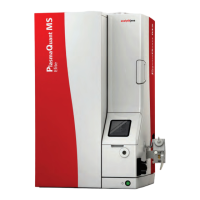PlasmaQuant MS product family Function and setup of the PlasmaQuant MS
25
This first stage of the vacuum rapidly expands the plasma at supersonic speeds
producing a beam of particles that are guided later-on to the mass spectrometer
system.
This first part of the vacuum system can easily be brought to atmospheric pressure for
maintenance while the mass spectrometer system remains under vacuum.
Fig. 8 PlasmaQuant MS with unlatched interface door
1 Handle of the interface door
2
Plasma viewing window
3 Ion source with torch and induction coil
4
Sampler cone (which is the beginning of the
interface)
The sampler and skimmer cones are used to extract the ions from the plasma at
atmospheric pressure, and transfer the ion beam into a high-vacuum system. The
design of both cones has been optimized to provide low polyatomic ion formation,
high sensitivity, and excellent long-term stability. The larger sampler cone “samples”
the ions directly from the plasma. The skimmer cone then collects a portion of the
supersonic jet formed behind the sampler cone. Cones are constructed of nickel and
are suitable for most applications; platinum-tipped cones are available for samples
containing high levels of corrosive acids (HF, H
2
SO
4
, H
3
PO
4
).

